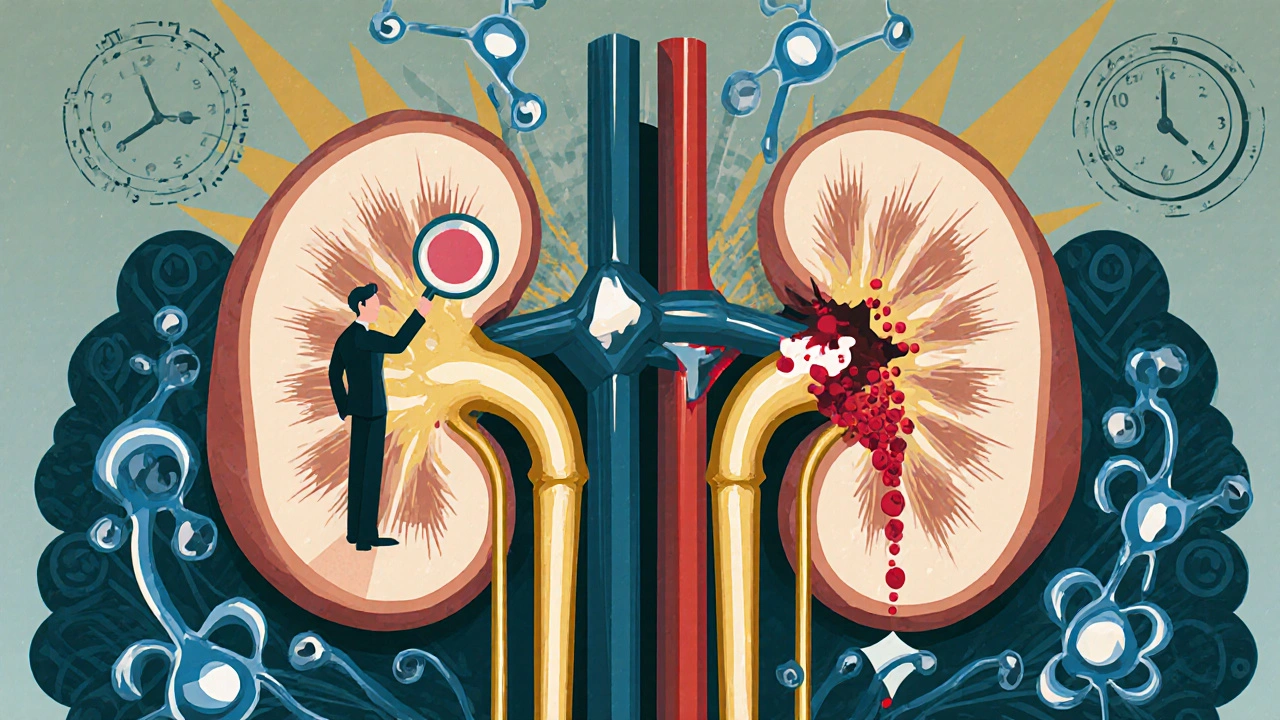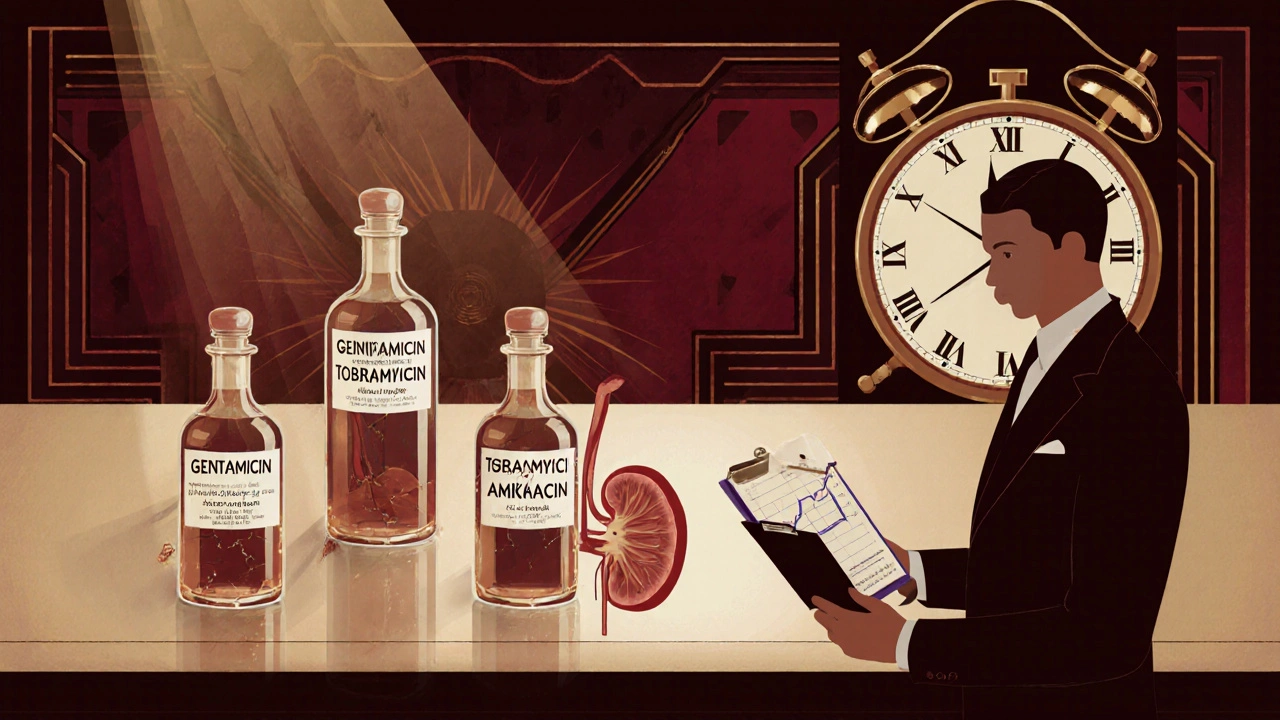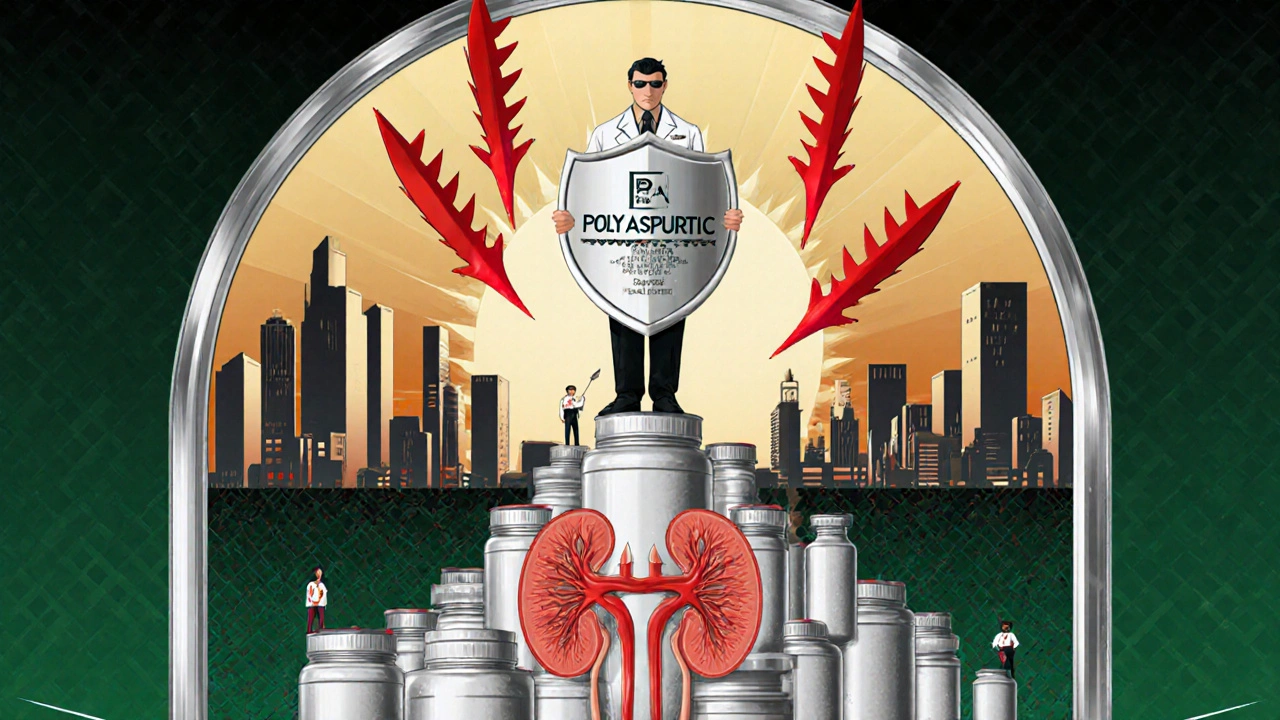Aminoglycoside Antibiotics and Kidney Damage: What You Need to Know About Nephrotoxicity

Aminoglycoside Nephrotoxicity Risk Calculator
This tool helps assess your risk of kidney damage when taking aminoglycoside antibiotics like gentamicin, tobramycin, or amikacin based on your individual clinical factors. Understanding your risk can help you discuss safer treatment options with your doctor.
Your Risk Assessment
When you’re fighting a serious bacterial infection, especially one caused by tough Gram-negative bugs like E. coli or Pseudomonas, doctors often turn to aminoglycoside antibiotics. Drugs like gentamicin, tobramycin, and amikacin work fast and kill bacteria effectively. But there’s a dark side: for 1 in 5 people taking them, these antibiotics start damaging the kidneys. It’s not rare. It’s not accidental. It’s built into how the drug works.
How Aminoglycosides Hurt the Kidneys
These antibiotics don’t just float through your body. After they’re filtered by the kidneys, about 5% of the dose gets stuck in the cells lining the proximal tubules-the same cells that reabsorb nutrients and water. That’s where the trouble begins. The drugs pile up inside lysosomes, the cell’s recycling centers, and start messing with their function. Over time, these lysosomes swell into giant, abnormal bubbles called myeloid bodies. Under the microscope, you can see mitochondria swelling, the endoplasmic reticulum breaking down, and even the nucleus getting distorted.
This isn’t just cell stress. It’s cell death. The damage triggers inflammation and oxidative stress, which leads to apoptosis-programmed cell death. And here’s the kicker: the kidneys don’t just shut down suddenly. The injury builds slowly. You won’t feel it. You won’t notice less urine. That’s because aminoglycoside-induced kidney damage is usually nonoliguric: you’re still peeing more than 400 mL a day, even as your kidney function drops.
When Does Kidney Damage Show Up?
Most people don’t see signs until after 5 to 7 days of treatment. The first clue? A rise in serum creatinine. A jump of 0.5 mg/dL or more above baseline is a red flag. Blood tests might also show low levels of magnesium, calcium, or potassium in the blood-signs the tubules can’t reabsorb them anymore. Urine tests reveal proteins like beta-2-microglobulin and enzymes like N-acetylglucosaminidase, which leak out when tubule cells are damaged.
It’s not a quick crash. It’s a slow leak. And that’s why it’s so easy to miss. Routine monitoring catches some cases, but not all. Even with careful tracking, nephrotoxicity still happens in 10% to 25% of patients. That’s not a failure of monitoring-it’s a flaw in the drug itself.
Who’s at Highest Risk?
Not everyone gets kidney damage. But some people are far more vulnerable.
- People over 65-aging kidneys have less reserve and less ability to repair.
- Those with pre-existing kidney disease (eGFR under 60 mL/min)-their risk triples.
- Patients on vancomycin at the same time-this combo raises the risk by nearly threefold.
- Anyone dehydrated or with low blood volume-the kidneys get less blood flow, so drugs concentrate more in the tubules.
- People on treatment longer than 7 days-the longer the exposure, the more damage accumulates.
It’s not just about the drug. It’s about the person. A 70-year-old with diabetes and a urinary tract infection on gentamicin for 10 days? That’s a perfect storm.

Dosing Matters More Than You Think
One of the biggest shifts in clinical practice happened when researchers realized that how you give the drug changes how much damage it causes.
For decades, aminoglycosides were given in 3 doses a day. Then, in the 1990s, studies showed that giving the same total daily dose in just one large dose reduced kidney damage. Why? Because high peak levels kill bacteria effectively, but low trough levels give the kidneys time to clear the drug before it builds up in the tubules.
Even more surprising? Timing matters. Studies found that giving the dose at 1:30 p.m. led to less kidney injury than giving it in the morning or at night. It’s likely tied to circadian rhythms-kidney cells repair themselves more efficiently during certain parts of the day.
And not all aminoglycosides are equal. Gentamicin is the most nephrotoxic. Amikacin is slightly safer at equivalent doses. But all of them carry the same risk mechanism. Switching from gentamicin to amikacin won’t eliminate the danger-it just lowers it a bit.
Recovery Is Possible-But Not Guaranteed
Here’s the good news: most people recover. After stopping the drug, kidney function usually starts to improve within 3 to 5 days. Full recovery often takes 1 to 3 weeks. A 2021 study of over 1,200 patients found that 82% had partial or complete recovery within 30 days of stopping therapy.
But that leaves 18% who don’t fully bounce back. Some end up with permanent kidney damage. A few even need long-term dialysis. And once you’ve had aminoglycoside-induced kidney injury, your kidneys are more vulnerable the next time you’re exposed to nephrotoxins.
What Doctors Do to Prevent It
Current guidelines from the European Society of Clinical Microbiology and Infectious Diseases (2023) are clear:
- Use once-daily dosing, not multiple daily doses.
- Check serum creatinine every 48 to 72 hours.
- Keep gentamicin trough levels below 1 μg/mL.
- Avoid combining with other kidney-damaging drugs like vancomycin, NSAIDs, or contrast dye.
- Hydrate patients well-especially before and during treatment.
- Limit treatment to 7 days or less whenever possible.
But here’s the problem: even when all these rules are followed, nephrotoxicity still happens. That’s because we’re still missing something. We know how the drug enters the cells. We know how it damages them. But we don’t yet have a drug that blocks it safely in humans.

What’s on the Horizon?
Researchers are working on solutions. One promising candidate is polyaspartic acid. In lab studies, it acts like a shield. It binds to the aminoglycoside before the drug can stick to kidney cells. In animal models, it completely prevented the formation of myeloid bodies, protected mitochondria, and stopped phospholipid buildup-all signs of early kidney damage.
But here’s the catch: polyaspartic acid isn’t approved for use in people yet. A modified version is now in Phase II clinical trials in the U.S. as of late 2023. If it works, it could be the first real protective agent for aminoglycoside users.
Other research is looking at antioxidants to block the oxidative stress caused by the drugs, or drugs that stop the apoptosis pathway before it kills tubule cells. The National Institute of Diabetes and Digestive and Kidney Diseases has poured over $24 million into this research since 2021. But translation from lab to clinic takes time.
Why We Still Use Them
So why keep using a drug that hurts kidneys so often?
Because sometimes, there’s no choice. For multidrug-resistant infections-like those caused by carbapenem-resistant Enterobacteriaceae-aminoglycosides are often the last effective option. Global use is estimated at 12.5 million treatment courses a year. In intensive care units, they’re life-saving.
The goal isn’t to stop using them. It’s to use them smarter. Shorter courses. Careful monitoring. Once-daily dosing. Avoiding combinations. And, someday, adding a protective agent.
For now, the message is simple: if you’re on an aminoglycoside, your kidneys are at risk. Your doctor should know that. And you should too. Ask: How long will I be on this? Are you checking my kidney function? Is there a safer alternative? These aren’t just questions-they’re part of your safety net.
The Bigger Picture
Aminoglycoside nephrotoxicity isn’t just a side effect. It’s a trade-off. We’re trading kidney risk for survival. And as antibiotic resistance grows, that trade-off becomes more common.
Understanding how these drugs damage the kidneys isn’t just academic. It’s practical. It tells us when to watch, when to act, and when to say no. It shows us why once-daily dosing works better. Why hydration matters. Why vancomycin is dangerous with gentamicin. Why we need better protectants.
For now, we manage the risk. We don’t eliminate it. But we’re learning. And that’s the only path forward.
